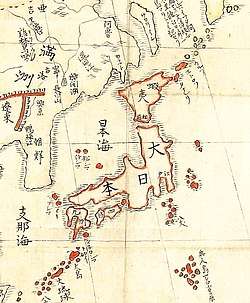Hōgen (era)
Hōgen (保元) was a Japanese era name (年号,, nengō,, lit. "year name") after Kyūju and before Heiji. This period spanned the years from April 1156 through April 1159.[1] The reigning emperors were Emperor Go-Shirakawa-tennō (後白河天皇) and Emperor Nijō-tennō (二条天皇).[2]
| History of Japan |
|---|
 |
Change of era
- January 24, 1156 Hōgen gannen (保元元年): The new era name was created to mark an event or series of events. The previous era ended and a new one commenced in Kyūju 3, on the 24th day of the 4th month of 1156.[3]
Events of the Hōgen era
- July 20, 1156 (Hōgen 1, 2nd day of the 7th month): Cloistered Emperor Toba-in died at age 54.[4]
- July 28–August 16, 1156 (Hōgen 1, 10th-29th days of the 7th month): The Hōgen Rebellion,[5] also known as the Hōgen Insurrection or the Hōgen War.
- 1156 (Hōgen 1, 9th month): The naidaijin Fujiwara Saneyoshi was named sadaijin. The dainagon Fujiwara Koremichi became naidaijin. After the war, tranquility was restored throughout the empire; and the emperor himself was in charge of the government. A special building was constructed in Kyoto, where—as in the days of Emperor Go-Sanjo, requests and complaints were received and examined.[6]
- 1157 (Hōgen 2, 8th month): Sanjō Saneyuki was dismissed from his position as daijō-daijin; and in the same month, the sadaijin Saneyoshi died. The udaijin Fujiwara no Munesuke was made daijō-daijin. The naidaijin Koremichi was made sadaijin. Fujiwara no Moresane, who was the 15-year-old son of son of kampaku Fujiwara no Tadamichi, became udaijin. The dainagon Sanjō Kinori, who was the son of Saneyuki, obtained the position of naidaijin.[6]
- 1157 (Hōgen 2, 10th month): The foundations are laid for a grand audience hall (dairi) in the palace. There had not been such a structure within the palace compound since the time of Emperor Shirakawa.[6]
- August 6, 1158 (Hōgen 3, 11th day of the 8th month): In the 3rd year of Go-Shirakawa's reign (後白河天皇25年), the emperor abdicated; and the succession (senso) was received by his eldest son.[7]
- 1158 (Hōgen 4, 8th month): Emperor Nijō is said to have acceded to the throne (sokui).[8]
Notes
- Nussbaum, Louis-Frédéric. (2005). "Hōgen" in Japan Encyclopedia, p. 339, p. 339, at Google Books; n.b., Louis-Frédéric is pseudonym of Louis-Frédéric Nussbaum, see Deutsche Nationalbibliothek Authority File.
- Titsingh, Isaac. (1834). Annales des emepereurs du japon, pp. 188-194; Brown, Delmer et al. (1979). Gukanshō, pp. 326-329; Varley, H. Paul. (1980). Jinnō Shōtōki, pp. 205-212.
- Brown, p. 327.
- Brown, p. 321; Kitagawa, H. (1975). The Tale of the Heike, p.783.
- Kitagawa, p. 783.
- Titsingh, p. 190.
- Titsingh, p. 190; Brown, p. 327; Varley, p. 44, 209; a distinct act of senso is unrecognized prior to Emperor Tenji; and all sovereigns except Jitō, Yōzei, Go-Toba, and Fushimi have senso and sokui in the same year until the reign of Emperor Go-Murakami.
- Titsingh, p. 191.
gollark: I don't think IBM does much innovative computer-y stuff these days. But knowing basic stuff about computers and networking is useful and important.
gollark: I have an old copy of `ungoogled-chromium` for sites which won't work properly without it (!!!) but don't use it for regular browsing.
gollark: Firefox.
gollark: I assume someone else has written the dark theme code already.
gollark: Yes, I too love constant current sources in my browser.
References
- Brown, Delmer M. and Ichirō Ishida, eds. (1979). Gukanshō: The Future and the Past. Berkeley: University of California Press. ISBN 978-0-520-03460-0; OCLC 251325323
- Nussbaum, Louis-Frédéric and Käthe Roth. (2005). Japan encyclopedia. Cambridge: Harvard University Press. ISBN 978-0-674-01753-5; OCLC 58053128
- Titsingh, Isaac. (1834). Nihon Odai Ichiran; ou, Annales des empereurs du Japon. Paris: Royal Asiatic Society, Oriental Translation Fund of Great Britain and Ireland. OCLC 5850691
- Varley, H. Paul. (1980). A Chronicle of Gods and Sovereigns: Jinnō Shōtōki of Kitabatake Chikafusa. New York: Columbia University Press. ISBN 9780231049405; OCLC 6042764
External links
- National Diet Library, "The Japanese Calendar" -- historical overview plus illustrative images from library's collection
| Preceded by Kyūju |
Era or nengō Hōgen 1156–1159 |
Succeeded by Heiji |
This article is issued from Wikipedia. The text is licensed under Creative Commons - Attribution - Sharealike. Additional terms may apply for the media files.